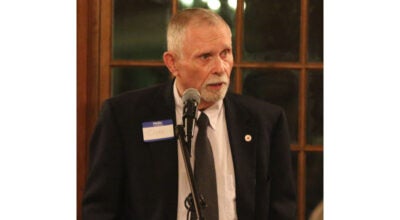On the good ship Mayflower
Published 12:06 pm Saturday, October 17, 2015
by James D. Howell
“The year 1620, the Pilgrims came over.
“The good ship Mayflower brought them ‘cross the sea…..”
The rule of primacy is strong in my life. The childhood, grammar school song sticks with me as we walk to the very place where the Pilgrims loaded up on the Mayflower and set out for the new world. Wooden wharves have long since been replaced with concrete ramparts and slips. The event itself is memorialized with a monument, plaque and American flag, flown alongside the British. Suffice it to say that we are no more than a hundred feet or so away from the actual spot, regardless of direction.
We’re in Plymouth, a sizable, busy city, the largest on England’s south coast. We drove over from Salcombe, taking the scenic route along lesser traveled country roads, some with towering hedgerows on either side. Our seats in the taller van help us see over the tops. Our path takes us through small towns with beautiful names, like Brixton, Marlborough, Yealmton and Modbury. I feel as if I’ve stepped into a nursery rhyme. The villages are mostly nestled onto a paved road with little or no space between the buildings and the pavement. All are interesting and deserve further investigation, but our schedule will not permit the slower pace. Today it’s to be Plymouth.
Our visit starts with Charles Cross Church, a major landmark, and focal point of Plymouth. During World War II, German incendiary bombs burned out this, the largest church in Plymouth. The church is not rebuilt, rather its skeletal frame has been allowed to stand as a reminder of the horrors of war. Arched windows, missing their stained glass filler, appear as mouths open in mourning. Green grass in contrast to dull gray stone, exaggerates the somber aspect. We are respectful.
A short walk and a little shopping later, we arrive at the Mayflower Steps. It’s a part of the Barbican, the oldest part of Plymouth harbor. This is where most shipping arrived and departed during earlier sailing days, and was the most fortified against invaders.
On an adjacent wall, a large plaque lists the Mayflower passengers embarked, including servants and indentured servants. The crew is not recorded; most estimates are around 30. So, on board was about 132 people, several small animals, provisions for people (and animals) and starting supplies for the new colony. All crammed into a cargo ship about a hundred feet long.
The Mayflower was chartered from London. It sailed, with passengers, to Southampton, where it met up with the Speedwell and its passengers from Holland. They planned to cross the Atlantic together. The Speedwell developed leaks; repairs were made in Southampton and both ships departed for the New World. Some three hundred miles at sea, the Speedwell again developed leaks and both ships returned to port at Plymouth for repairs. A decision was made to transfer passengers and supplies to the Mayflower and continue the voyage leaving the Speedwell behind.
The Mayflower departed for the New World alone. Passengers had already been aboard the ship for a month. Years later, found documents give a clearer picture of the passengers, including the presence of the Leiden, Holland, separatist group. Before now, I was not aware of the Speedwell or Leidenists (by name). So much for my recall of American colonization.
History does not record exactly how the ship got underway. Maybe it used a towboat powered by a half dozen oarsmen to get it out into the retreating tide. They certainly used the tide to clear the headlands into open water. Sailing vessel crews were adept at moving ships around in difficult circumstances.
“They landed at Plymouth Rock, then built up their houses.
“At harvest time they started our Thanksgiving Day.”
About a 132 brave souls, departed this place on Sept.r 6, 1620; on Nov. 21, they landed at, or close to, what is now Provincetown, Massachusetts. A storm blew them north of their original Virginia destination. They had a good idea where they were and made one attempt to move further south to their original destination, but weather (and fatigue, I suppose) caused them to return to modern day Cape Cod. They explored and established their colony at what is now Plymouth, Massachusetts.
En route, the settlers agreed on wording for a document called the Mayflower Compact. It was a set of mostly democratic guidelines for the colony that some feel influenced the writing of the US Constitution many years later.
I stand at the Steps, my mind trying to understand that which cannot be understood – the motivations of the adventurers, and the serendipity of history. I will not celebrate Thanksgiving again without remembering this moment.
JAMES D. “ARCHIE” HOWELL is a Southampton County native and 1955 graduate of Franklin High School. He can be reached at archiepix@kingwoodcable.com.





